Morphosedimentary and geoarchaeological records during the last 1400 years in the Ebro depression (NE Spain) and their paleoenvironmental significance.
Peña-Monné, J.L., Sampietro-Vattuone, M.M., Picazo-Millán, J.V., Longares-Aladrén, L.A., Pérez-Lambán, F., Sancho-Marcén, C., Fanlo, J., 2022. Morphosedimentary and geoarchaeological records during the last 1400 years in the Ebro depression (NE Spain) and their paleoenvironmental significance. The Holocene |

ABSTRACT.
Most studies about the geomorphological evolution of the Holocene from NE Spain are focused on the period up to the Roman Era Epoch, with some references to medieval deposits also occasionally dated. This paper focuses on the aggradation units on the valley bottoms and slopes of the Ebro depression from 1400 BP to the present. These units were produced after the incision phase marking the end of the large Holocene accumulation (H1) around the 1400 BP (at the end of the Late Roman Epoch). Morphosedimentary records enable us to establish three aggradation units during the last 1400 years: unit H2 (ca. 1400-650 cal BP); unit H3 – with two H3A subunits (ca. 650-500 cal BP)
and H3B (ca. 500-320 cal BP); and the unit 4 (after 320 cal BP). These units are organized following five types of aggradation/incision arrangements with differing complexities. There are also connections among these units and two slope stages in the region. Finally, the genetic relationships between these units
and global environmental changes are shown (LALIA, MCA, LIA) and related to anthropic activity.



